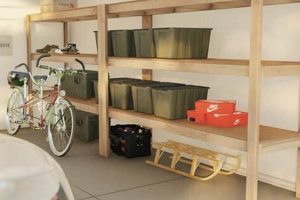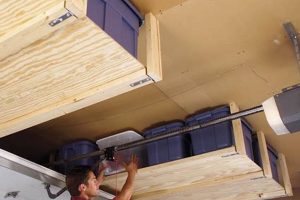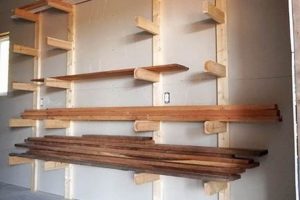Constructing overhead compartments for storing containers offers a space-saving solution for decluttering residential environments. This approach typically involves utilizing readily available materials and basic construction techniques to suspend storage bins from the ceiling structure of a garage, basement, or similar area. The result is an organized system where seasonal items, holiday decorations, or infrequently used possessions can be neatly housed without occupying valuable floor space. For example, individuals might build a frame from lumber and attach it to ceiling joists, subsequently suspending plastic containers from the frame using straps or hooks.
The value of such a storage implementation lies in maximizing underutilized vertical space, freeing up floor area for other purposes. This is particularly relevant in homes with limited storage capacity or where efficient organization is a priority. Historically, homeowners have sought creative methods for increasing storage; this specific application reflects a broader trend toward innovative solutions for space management. Furthermore, implementing an elevated organization system contributes to a more visually appealing and functional living environment.
The subsequent discussion will delve into the critical considerations for safely and effectively building and installing overhead container systems, including structural integrity, material selection, weight distribution, and various design adaptations. The information will cover essential safety measures and provide detailed instructions for ensuring a robust and secure end result.
Tips for Overhead Container Systems
Constructing stable and functional overhead container storage requires careful planning and precise execution. The following guidelines offer critical insights for a successful implementation.
Tip 1: Structural Assessment is Paramount: Prior to initiating any construction, evaluate the ceiling’s load-bearing capacity. Identify joists and ensure they are capable of supporting the combined weight of the storage structure and the filled containers. Consult a structural engineer if there are any doubts about the ceiling’s integrity.
Tip 2: Precise Measurement and Planning: Accurate measurements of the available space are essential. Determine the dimensions of the storage containers and allocate sufficient clearance to allow for easy access and maneuverability. A detailed plan or schematic will prevent errors and wasted materials.
Tip 3: Material Selection for Durability: Choose robust materials that can withstand the intended load and environmental conditions. Lumber should be appropriately treated to prevent rot or insect infestation. Fasteners, such as screws and bolts, must be of sufficient strength and corrosion-resistant.
Tip 4: Secure Fastening Techniques: Employ reliable fastening techniques to ensure the structural integrity of the overhead system. Use appropriate screws or bolts to securely attach the frame to the ceiling joists. Reinforce joints with metal brackets or gussets where necessary.
Tip 5: Weight Distribution Considerations: Distribute the weight evenly across the storage structure to prevent overloading any single point. Avoid concentrating heavy items in one container or section of the system. Consider using multiple support points to distribute the load more effectively.
Tip 6: Safety Mechanisms for Container Security: Implement safety measures to prevent containers from accidentally falling. Utilize secure straps, hooks, or latches to hold the containers firmly in place. Regularly inspect these mechanisms for wear or damage.
Tip 7: Accessibility and Ergonomics: Design the system to allow for easy access to the stored items. Consider the height and reach required to lift and lower containers safely. Implement features such as pull-down mechanisms or ladders for improved accessibility.
These guidelines are intended to promote safe and efficient construction. Adhering to these recommendations will result in a robust and reliable overhead container organizational solution.
The following sections will provide detailed instructions on assembling different types of overhead container storage systems and will reiterate the importance of adhering to relevant safety protocols.
1. Structural Integrity
Structural integrity is paramount in the context of overhead container systems. Ensuring that a self-assembled system can safely support the intended load is not merely a best practice but a fundamental requirement for preventing catastrophic failure and potential injury. The following facets elaborate on the critical aspects of structural integrity in relation to these storage solutions.
- Joist Load Capacity Assessment
Ceiling joists are designed to bear specific loads. Exceeding these load limits can result in sagging, cracking, or even collapse. Before construction, the load-bearing capacity of the joists must be determined. This involves identifying joist size, spacing, and span, and comparing these specifications against applicable building codes and load tables. Inadequate assessment can lead to structural compromise.
- Material Strength and Selection
The materials used for the storage frame, supports, and fasteners must possess sufficient strength to withstand the anticipated weight. Lumber grade and type are critical considerations. Fasteners, such as screws and bolts, should be of appropriate size and material to prevent shearing or loosening under load. Compromising on material quality can undermine the entire structure’s integrity.
- Fastening Techniques and Joint Strength
The methods used to connect structural components significantly impact overall stability. Improperly secured joints are a common point of failure. Techniques such as screwing, bolting, and the use of metal brackets must be executed with precision and in accordance with established construction practices. Weak joints compromise the system’s ability to distribute weight effectively.
- Weight Distribution and Load Balancing
The distribution of weight across the storage system is crucial for preventing localized stress concentrations. Concentrated loads can overstress individual joists or connection points. Equalizing the load distribution involves strategically placing containers and ensuring that weight is evenly supported across the frame. Imbalanced loading can lead to premature failure.
These facets demonstrate the multi-faceted nature of structural integrity in overhead container projects. Each element is integral to the overall stability and safety of the system. A comprehensive understanding of these factors and a commitment to sound construction practices are essential for creating a safe and reliable storage solution, mitigating the risks associated with structural failure and ensuring long-term functionality.
2. Weight Capacity
Weight capacity represents a critical parameter in the design and implementation of overhead container systems. The ability of the system to safely bear the intended load dictates its functionality and longevity, and directly impacts the safety of the surrounding environment.
- Joist Load Rating Determination
The foundation of any safe overhead storage system rests upon a thorough understanding of the ceiling joists’ load-bearing capabilities. Joist size, spacing, span, wood species, and grade all contribute to its ability to support weight. Building codes and engineering tables provide guidelines for determining safe load limits based on these factors. Accurate assessment prevents overloading and potential structural failure. For example, a system attached to 2×6 joists spaced 24 inches apart will have a significantly lower weight capacity than one attached to 2×10 joists spaced 16 inches apart.
- Material Selection Based on Load
The materials used to construct the storage frame must be selected based on the calculated load requirements. Lumber, steel, and engineered wood products each possess distinct strength characteristics. The chosen material must provide an adequate safety margin to account for variations in weight distribution and potential overloading. For instance, using undersized lumber for the frame can lead to sagging or breakage under heavy loads, rendering the system unsafe.
- Fastener Strength and Spacing
Fasteners, such as screws, bolts, and lag bolts, play a vital role in transferring the load from the storage frame to the ceiling joists. The strength, size, and spacing of these fasteners must be carefully considered to ensure a secure connection. Insufficient or improperly installed fasteners can become points of failure, leading to the collapse of the system. For example, using drywall screws to attach a heavy storage frame to ceiling joists is inadequate and poses a significant safety risk.
- Distribution of Weight and Load Balancing
Even distribution of weight across the storage system is crucial to preventing localized stress concentrations. Concentrated loads can overstress individual joists or connection points, increasing the risk of failure. Proper weight distribution involves strategically placing containers and ensuring that the load is evenly supported across the frame. For example, placing all heavy items in one corner of the storage system can overload the adjacent joists, potentially causing structural damage.
These considerations highlight the intricate relationship between weight capacity and the success of overhead storage projects. Failure to accurately assess load limits, select appropriate materials, and ensure proper weight distribution can result in structural failure, property damage, and potential injury. Careful planning and adherence to sound construction practices are essential for creating a safe and reliable storage solution.
3. Accessibility
Accessibility represents a critical design parameter in overhead container projects. While maximizing storage space is the primary objective, the ease with which stored items can be retrieved or placed significantly impacts the system’s overall utility and practicality. Difficulty in accessing items negates the benefits of increased storage capacity, rendering the system inefficient and potentially hazardous. Cause-and-effect relationships are evident: poor accessibility leads to infrequent usage, frustration, and a potential disinclination to maintain organization. Consequently, designing for accessibility is not merely a convenience; it is a fundamental component of a successful overhead storage system. For instance, systems installed too high, lacking proper access mechanisms, often become repositories for infrequently used items, ultimately defeating the purpose of efficient storage. In contrast, a well-designed system with easily operated lowering mechanisms or strategically positioned access points encourages regular use and maintains a higher degree of organization.
Practical considerations for enhanced accessibility include the selection of appropriate lifting or lowering mechanisms. Pulley systems, crank-operated lifts, or even strategically placed ladders can improve access, particularly for heavier containers or individuals with limited physical capabilities. Furthermore, the orientation and arrangement of containers within the system influence accessibility. Clearly labeled containers, positioned with frequently used items readily available, significantly reduce the effort required to locate and retrieve specific possessions. An example of practical application includes a garage storage system where holiday decorations are stored in labeled containers that can be lowered via a pulley system. This ensures easy access during the holiday season and minimizes the need for precarious ladder climbing.
In conclusion, accessibility is an indispensable factor in designing and implementing effective overhead container setups. Overlooking this aspect leads to reduced usability and potential safety hazards. Thoughtful consideration of access mechanisms, container placement, and labeling strategies ensures that the system remains a functional and practical storage solution. Challenges related to limited space or budget constraints can be addressed through creative design adaptations and the prioritization of frequently accessed items. Prioritizing accessibility transforms a potentially cumbersome storage solution into a valuable asset for maintaining an organized and efficient living or working space.
4. Material Durability
Material durability is a linchpin of successful DIY ceiling tote implementations. The sustained effectiveness of an overhead storage system hinges directly on the resilience of its constituent materials to withstand gravitational forces, environmental conditions, and repeated usage. Failure to prioritize material durability inevitably leads to structural degradation, system failure, and potential safety hazards. For example, a storage system constructed from untreated lumber in a humid environment will experience rot and eventual collapse, regardless of the soundness of the design. The cause-and-effect relationship is direct: inferior materials yield inferior results.
The selection of durable materials extends beyond the primary structural components to encompass fasteners, support straps, and even the containers themselves. Substandard fasteners corrode and weaken over time, compromising joint integrity. Similarly, containers made from brittle plastic may crack or shatter under load, scattering contents and posing a risk of falling debris. In practical applications, systems employing pressure-treated lumber, steel support brackets, and heavy-duty polypropylene containers demonstrably exhibit superior longevity and stability compared to systems utilizing less robust alternatives. Consider a garage environment subject to temperature fluctuations; a steel-framed structure is significantly more resistant to warping than a wood-framed structure, ensuring consistent load-bearing capacity over time.
In conclusion, material durability should be a primary consideration in the design and construction of overhead storage systems. The consequences of neglecting this factor range from inconvenience to genuine safety risks. A commitment to using high-quality, durable materials is not merely an investment in the storage system itself, but also an investment in the safety and longevity of the surrounding environment. Addressing the challenges posed by budget constraints requires a strategic prioritization of material selection, focusing on the most critical structural components and opting for proven, durable alternatives where possible. Prioritizing this element will create systems that are robust, reliable, and ultimately, a worthwhile enhancement to any space.
5. Installation Safety
Safe installation practices are paramount when constructing overhead container systems. The elevated nature of these structures necessitates strict adherence to safety protocols to mitigate the risk of accidents and injuries during the installation process. Improper installation jeopardizes the structural integrity of the system and poses ongoing hazards to individuals in the vicinity.
- Personal Protective Equipment (PPE) Usage
The consistent use of appropriate PPE is fundamental to preventing injuries during installation. Safety glasses protect against flying debris, work gloves provide grip and prevent cuts, and a hard hat shields against head injuries from falling objects or accidental impacts. The absence of PPE increases the likelihood of preventable injuries, such as eye damage, lacerations, and concussions, which can significantly impair or delay the installation process. For example, failing to wear safety glasses while drilling into ceiling joists can result in wood splinters or metal shavings lodging in the eye, necessitating medical attention.
- Ladder Safety and Stability
Ladders are frequently used during the installation of overhead container systems. Ensuring the ladder is stable, properly positioned, and used according to manufacturer instructions is critical for preventing falls. Overreaching, placing the ladder on uneven surfaces, or exceeding its weight capacity significantly increases the risk of falls, resulting in injuries ranging from sprains to fractures. A common example is placing a ladder on a stack of unsecured boxes to gain additional height, which compromises stability and creates a hazardous situation.
- Electrical Hazard Awareness
Working near electrical wiring presents a significant risk during the installation of overhead storage systems. Before commencing work, identify the location of electrical wires and take precautions to avoid contact. De-energizing circuits, using insulated tools, and maintaining a safe distance from exposed wiring are essential safety measures. Contact with live electrical wires can result in severe burns, electrocution, or even death. For example, accidentally drilling through a concealed electrical wire while attaching the storage frame to ceiling joists poses a potentially fatal risk.
- Proper Lifting Techniques
Lifting heavy materials or components during installation requires proper lifting techniques to prevent back injuries. Bending at the knees, keeping the back straight, and avoiding twisting motions are essential for minimizing strain on the spine. Lifting heavy loads alone or without proper assistance significantly increases the risk of back injuries, which can result in chronic pain and long-term disability. For instance, attempting to lift a fully assembled storage frame overhead without assistance can easily lead to a debilitating back injury.
Adherence to these safety protocols is essential for ensuring a safe and successful installation of overhead container setups. Neglecting safety measures not only increases the risk of accidents and injuries but also compromises the structural integrity and long-term reliability of the system. Prioritizing safety throughout the installation process is a fundamental responsibility when creating these DIY storage systems.
6. Space Optimization
Space optimization, in the context of residential or commercial environments, refers to the efficient and effective utilization of available area to maximize functionality and minimize clutter. Integrating overhead container systems represents a strategic approach to realizing space optimization goals, particularly in areas where floor space is limited or at a premium. These systems capitalize on unused vertical space, transforming it into valuable storage capacity.
- Vertical Space Utilization
Overhead container systems directly address space optimization by utilizing the often-underutilized vertical dimension of a room. Standard storage solutions, such as shelving units or floor-standing cabinets, occupy valuable floor space, reducing the usable area within a given environment. By suspending containers from the ceiling, the footprint of the storage system is minimized, freeing up floor space for other purposes. For example, a garage with limited floor space can benefit significantly from an overhead container system, allowing for the storage of seasonal items without encroaching on parking or workspace.
- Decluttering and Organization
These systems facilitate decluttering and promote organized storage practices. By providing a designated location for infrequently used items, overhead storage reduces the accumulation of clutter on floors and other surfaces. Organized storage enables efficient retrieval of items when needed and prevents the loss or misplacement of possessions. A well-organized overhead container system in a basement, for instance, allows for the storage of holiday decorations, sporting equipment, and other seasonal items in a readily accessible and organized manner.
- Maximizing Functional Area
Effective space optimization directly contributes to maximizing the functional area within a room or building. By removing clutter and organizing storage, overhead systems create more usable space for activities such as work, recreation, or living. A clear and organized environment enhances productivity, reduces stress, and improves overall quality of life. For example, a home office with an overhead container system for storing files and supplies can create a more efficient and productive workspace, free from distractions and clutter.
- Adaptability and Customization
Overhead container systems can be tailored to meet specific space optimization needs through adaptable designs and customizable configurations. Systems can be designed to accommodate various container sizes and shapes, allowing for efficient storage of a wide range of items. Adjustable height settings and modular components provide further flexibility to adapt the system to changing storage requirements. For example, a workshop can utilize a customized overhead container system to store tools, hardware, and materials in an organized and easily accessible manner, maximizing the usable workspace and promoting efficient workflow.
Integrating overhead container systems into residential or commercial spaces offers a strategic approach to space optimization. By capitalizing on unused vertical space, promoting decluttering and organization, maximizing functional area, and providing adaptability and customization, these systems contribute significantly to creating efficient, functional, and aesthetically pleasing environments. The benefits of optimized space extend beyond mere convenience, impacting productivity, safety, and overall quality of life.
7. Cost Effectiveness
Cost effectiveness is a significant consideration in the realm of overhead container organizational solutions. Opting for a self-assembled approach frequently presents a financially prudent alternative to purchasing commercially manufactured systems. This approach offers the potential for substantial savings, contingent upon material selection, construction methods, and efficient resource management.
- Material Sourcing and Procurement
A primary avenue for cost reduction lies in the strategic sourcing of materials. Utilizing reclaimed lumber, repurposing existing hardware, and taking advantage of sales or discounts on construction materials can substantially lower the overall investment. For example, obtaining lumber from deconstructed structures or purchasing fasteners in bulk can yield significant savings compared to purchasing new materials at retail prices. Prudent material sourcing is essential for maximizing cost effectiveness in a self-assembled project.
- Labor Cost Reduction
By undertaking the construction process oneself, individuals eliminate the labor costs associated with professional installation services. This self-sufficiency translates directly into financial savings, particularly for projects involving complex designs or large-scale implementations. However, it is crucial to acknowledge the value of one’s time and to accurately assess one’s skillset before embarking on a DIY project. The value of time is offset by the need to learn the skillset.
- Customization and Adaptability
The self-assembled approach allows for greater customization and adaptability, potentially leading to cost savings by optimizing material usage and avoiding unnecessary features. Designing a system that precisely meets specific storage needs minimizes waste and eliminates the need for costly modifications or add-ons. For instance, a custom-built system can be tailored to accommodate containers of specific dimensions, avoiding the need to purchase additional containers or modify existing ones.
- Long-Term Value and Maintenance
While the initial investment in a DIY project may be lower, it is important to consider long-term value and maintenance costs. Selecting durable materials and employing sound construction techniques minimizes the need for repairs or replacements, extending the lifespan of the system and reducing overall costs over time. Regularly inspecting and maintaining the system further contributes to its longevity and cost effectiveness. Systems failing to endure may diminish cost effectiveness with a high frequency of repairs. The trade-off in investment now might be worth investing in premium materials for the long-term.
These facets demonstrate the various ways cost effectiveness aligns with self-assembled overhead container systems. Strategic material sourcing, elimination of labor costs, customization opportunities, and a focus on long-term value all contribute to making DIY an economically sound choice. While DIY projects can offer savings, the investment in time is not free. Prioritizing safety and taking time will be valuable to ensure overall project success. However, it is imperative to conduct thorough research, possess adequate skills, and prioritize safety throughout the project to ensure a successful and cost-effective outcome.
Frequently Asked Questions
This section addresses common inquiries and concerns related to the design, construction, and implementation of overhead container storage solutions. The information presented aims to provide clarity and informed decision-making.
Question 1: What is the critical factor in determining the feasibility of implementing this system?
The structural integrity of the ceiling, specifically the load-bearing capacity of the joists, constitutes the critical factor. A thorough assessment of joist size, spacing, material, and condition is necessary to ensure the safe support of the storage system and its contents.
Question 2: Which materials are best suited for constructing the frame?
Lumber, steel, and engineered wood products are viable options. Material selection hinges on load requirements, environmental conditions, and budget considerations. Pressure-treated lumber is recommended for damp environments, while steel offers superior strength and durability.
Question 3: How should container weight be distributed for optimal safety?
Weight distribution should be uniform across the storage system to prevent localized stress concentrations. Heavy items should be strategically placed to distribute the load evenly across the support structure. Overloading individual containers or sections of the system should be avoided.
Question 4: What safety precautions must be observed during installation?
The use of personal protective equipment (PPE), including safety glasses, gloves, and head protection, is mandatory. Secure ladder placement and adherence to safe lifting techniques are essential. Awareness of electrical hazards and avoidance of contact with wiring are critical.
Question 5: How can accessibility to stored items be enhanced?
Accessibility can be improved through the implementation of lifting or lowering mechanisms, such as pulley systems or crank-operated lifts. Strategic container placement, clear labeling, and the use of ladders or step stools can further facilitate access.
Question 6: What factors contribute to the long-term cost effectiveness of a DIY system?
Cost effectiveness is enhanced through strategic material sourcing, self-installation, customization to specific storage needs, and the selection of durable materials to minimize maintenance and replacement costs.
The information presented in this FAQ section offers a concise overview of key considerations. Thorough planning, adherence to safety guidelines, and informed material selection are paramount for a successful and reliable overhead container system.
The following section will delve into specific design examples and case studies, illustrating practical applications of overhead container systems in various settings.
Conclusion
The preceding exploration of “diy ceiling tote storage” has underscored critical aspects of design, construction, and implementation. Structural integrity, weight capacity, accessibility, material durability, installation safety, space optimization, and cost-effectiveness have been identified as paramount considerations. A comprehensive understanding of these elements is essential for ensuring a successful and reliable system.
The utilization of overhead space for storage represents a strategic approach to maximizing spatial efficiency. Prudent planning and diligent execution are necessary to transform a conceptual design into a functional reality. Further research and adherence to established construction principles are encouraged to promote safe and effective storage solutions.







